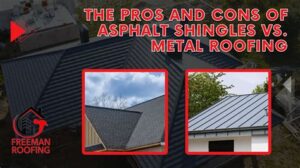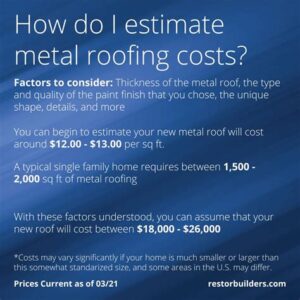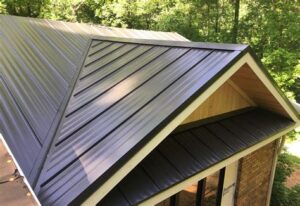When embarking on a roofing project, precision and preparation are essential, particularly when it comes to metal roofs. A comprehensive understanding of metal roof estimates not only simplifies the budgeting process but also ensures you procure the right materials. This guide aims to provide detailed insights into cut lists for metal roof estimate templates, highlighting the essential components and factors that influence costs. Furthermore, we will explore the invaluable benefits these templates bring, streamlining your project and enhancing accuracy. Whether you’re a contractor or a DIY enthusiast, our tips for creating an effective metal roof cut list will empower you to make informed decisions, paving the way toward a successful roofing experience. Dive in to discover everything you need to know about estimating costs and maximizing the advantages of your metal roofing project.
Understanding Metal Roof Estimates: A Complete Overview
When it comes to roofing, particularly with metal roofs, understanding the estimate process is crucial for both homeowners and contractors alike. Metal roofing offers durability and energy efficiency, but accurately estimating costs can be complex. In this section, we will explore the fundamental aspects of metal roof estimates to ensure you have a solid grasp of what to expect.
A metal roof estimate typically includes the total material costs, labor expenses, and any additional charges like permits, disposal fees, and unexpected contingencies. These estimates allow homeowners to compare different options, making informed decisions about their roofing project.
Key factors influencing the A Complete estimation include:
- Type of Metal: Different metal types (steel, aluminum, copper) have varying costs and benefits.
- Roof Size and Design: The square footage and complexity of the roof will affect material and labor costs.
- Geographical Location: Local labor rates and material availability can skew estimates significantly.
- Installation Method: The chosen installation technique, whether standing seam or corrugated, can impact overall expenses.
Additionally, metal roofing estimates often require detailed measurements and understanding building codes and regulations specific to your area. Having an accurate cut list prepared in advance can streamline the estimation process, ensuring that all necessary components and materials are accounted for.
Comprehending metal roof estimates is paramount to managing costs and ensuring your roofing project aligns with your budget while meeting your needs. By understanding these foundational elements, you can navigate the complexities of roofing estimates with confidence.
Essential Components of a Metal Roof Cut List
Creating a metal roof cut list is an essential step in the planning and budgeting process of roofing projects. A comprehensive cut list helps ensure that you have all the necessary materials on hand, which can significantly impact both cost and efficiency during installation. Below are the essential components that should be included in a metal roof cut list:
- Sheet Sizes: Specify the dimensions of the metal sheets required for the roofing project. Common sizes include 24-inch and 36-inch widths, but the size can vary based on the design and manufacturer.
- Types of Panels: Identify the specific types of metal panels you will use, such as standing seam, corrugated, or ribbed panels. Each type has different features and methods of installation.
- Quantity of Panels: Calculate the total number of panels needed, factoring in waste and overlaps. This ensures you order sufficient materials without excess.
- Accessories and Trim: List all necessary accessories, including flashing, trim pieces, and edging. These components are critical for protecting against water infiltration and enhancing the roof’s aesthetics.
- Fasteners: Specify the type and quantity of fasteners required for securing panels to the roof structure. Different materials and panel types may require unique fasteners.
- Underlayment and Insulation: Note the underlayment materials and any insulation that may need to be incorporated into the roofing system, as these are vital for energy efficiency and moisture management.
- Roof Pitch and Configuration: Document the pitch of the roof and its design configuration, which includes eaves, ridges, valleys, and penetrations. This information assists in determining appropriate panel lengths and cut angles.
By including these essential components in your metal roof cut list, you can create a more accurate estimate and ensure a smoother installation process. With a thoughtful approach to planning, you’ll be better prepared to handle the intricacies involved in roofing projects.
Calculating Costs: Factors Influencing Metal Roof Estimates
When it comes to estimating the costs associated with installing a metal roof, various factors come into play that can significantly affect the overall pricing. Understanding these factors is essential to create a A Complete metal roof estimate that is accurate and reflective of your specific project needs.
Here are the key factors influencing metal roof estimates:
- Material Type: The type of metal used—whether it’s steel, aluminum, or copper—will greatly impact the cost. Each material has its pricing tier based on durability and finish.
- Roof Size: The larger the roof, the more materials will be required. Accurate measurements will help in estimating the square footage, which is crucial for determining overall costs.
- Complexity of Design: Roofs with multiple angles, pitches, or features such as skylights will require more labor and materials, increasing costs. Simple designs are generally less expensive to install.
- Labor Costs: Local labor rates can vary widely. Understanding the going rates in your area will help you assess total installation costs. Experienced contractors may charge more but can provide superior workmanship.
- Additional Components: Elements like insulation, underlayment, and ventilation systems are often needed in conjunction with metal roofing. These added components should be factored into your estimate for a complete overview.
- Removal of Old Roofing: If old roofing materials need to be removed, this adds to labor and disposal costs. Ensure you account for this in your final assessment.
- Weather and Timing: Seasonal weather conditions can affect labor availability and material costs. It’s often more expensive to install in peak seasons.
By considering these factors when creating your metal roof estimate, you can develop a more A Complete understanding of the costs involved, ensuring a detailed and realistic budget for your project.
The Benefits of Using a Metal Roof Estimate Template
Utilizing a metal roof estimate template offers a variety of advantages that can streamline your roofing projects and enhance accuracy. Here are the key benefits:
- Increased Efficiency: With a pre-designed template, you can save valuable time during the estimating process. This allows you to focus on other critical aspects of the project.
- Enhanced Accuracy: Templates guide you in listing all necessary materials and components required for metal roofing. This reduces the possibility of overlooking essential items, leading to more precise cost estimates.
- Standardization: Using a template ensures that every estimate is consistent. This standardization is especially beneficial for businesses that provide multiple estimates, as it fosters professionalism and trust with clients.
- Customizability: A metal roof estimate template can be tailored to fit the specific needs of a project. This flexibility means you can adjust the template to include unique materials, labor costs, and project timelines.
- Improved Communication: Templates can also facilitate better communication with clients and contractors. By presenting a clear and organized estimate, you can easily explain project costs and logistics, minimizing misunderstandings.
- Opportunity for Cost Management: With a clear layout of costs and materials, it becomes easier to identify areas where savings can be made or where adjustments might be necessary, ultimately enhancing financial control over projects.
Overall, implementing a metal roof estimate template can significantly contribute to operational efficiency, reduce errors, and optimize project management, making it a worthwhile investment for anyone involved in the roofing industry.
Tips for Creating an Effective Metal Roof Cut List
Creating a metal roof cut list can be a detailed process, but having a clear and organized approach will help ensure accuracy and efficiency. Here are some A Complete set of tips to guide you through the process:
- Measure Carefully: Start with precise measurements of the roof area to avoid any miscalculations. Use high-quality tools for measuring lengths and angles.
- Include All Components: Ensure that your cut list includes all necessary materials such as panels, flashings, trims, and fasteners. This helps prevent last-minute purchases.
- Account for Waste: Always factor in material waste. It’s wise to add around 10% more material to your cuts to cover any mistakes or unexpected damages.
- Organize by Zones: Break down the roof into sections or zones. This allows for a better overview and makes it easier to manage cutting and installation.
- Utilize Software Tools: Consider using estimation software to streamline the process. Many tools offer templates that can simplify creating a metal roof cut list.
- Check Local Building Codes: Make sure that your cut list complies with local regulations and codes to avoid legal issues and ensure safety.
- Review and Revise: After completing your cut list, take the time to review and check it for errors. Revise as necessary to ensure accuracy before proceeding with the ordering of materials.
By applying these tips, you can create a comprehensive and efficient metal roof cut list that facilitates a smoother roofing project, minimizing delays and reducing costs.
Frequently Asked Questions
What is a cut list in the context of metal roofing?
A cut list is a detailed list that outlines the sizes and quantities of metal roofing materials required for a project, ensuring accurate estimates and efficient use of materials.
Why is it important to have an accurate cut list for metal roofing?
An accurate cut list helps in reducing material waste, controlling costs, and ensuring that the roofing project runs smoothly and on schedule.
What are the key components included in a metal roof estimate template?
A metal roof estimate template typically includes material costs, labor costs, project timeline, and specific details like panel dimensions, fasteners, and additional materials needed.
How can I calculate the costs associated with a metal roof installation?
To calculate costs, sum the prices of all roofing materials (including panels, insulation, and fasteners), labor charges, and any additional expenses such as permits and site preparation.
What benefits does using a template for metal roof estimates offer?
Using a template streamlines the estimating process, ensures consistency, improves accuracy, and saves time during project planning and budgeting.
Can I customize a metal roof estimate template for my specific project?
Yes, most templates can be customized to fit the unique requirements of your project, including adjustments for different materials, sizes, and design considerations.
What common mistakes should I avoid when creating a metal roof cut list?
Avoid underestimating material sizes, failing to account for waste, and neglecting to include all necessary components in your cut list, which can lead to additional costs and project delays.





